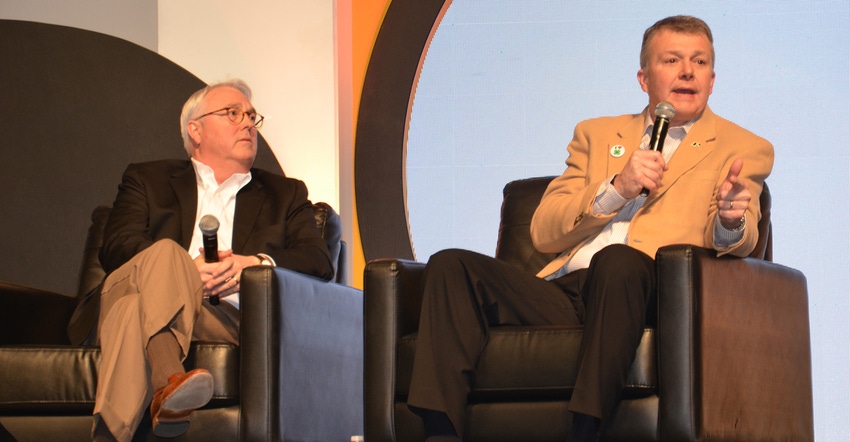February 25, 2019

Ag broadcaster Max Armstrong wasn’t about to let Purdue University’s five most recent College of Agriculture deans get off the stage without discussing the future of the Extension Service. Armstrong, an Indiana native and part of the Farm Progress team, was master of ceremonies for a reunion of former Purdue deans and the current dean at the Purdue Ag Alumni Fish Fry.
The ag deans included Bob Thompson, 1987 to 1993; Vic Lechtenberg, 1993 to 2003, Randy Woodson, 2004 to 2008; Jay Akridge, 2009 to 2017; and Karen Plaut, current dean. They represent leadership in Purdue’s College of Agriculture over the past 32 years.
Extension’s role
Armstrong posed this question: Is the Extension Service still relevant today? “It obviously was relevant in the beginning, but so many fewer people farm today, and there are many ways to communicate,” Armstrong explained as he posed the question.
“Extension was one of the three keys when the Morrill Act established land-grant colleges, and it’s still important today,” Akridge said. “A college like Purdue isn’t about buildings. It’s about people. The people are front and center in everything we do.”
Lechtenberg believes the future of the Extension program is still great today. “The need is still there,” he said. “It’s how we communicate ideas to the next generation. The mission may not be the same as it was 75 years ago, but it is still there. It’s how we get technology to the world.”
Lechtenberg recalled when people from other countries would come visit him during his tenure. “Many of them were from places where they had three separate groups doing research, education and engagement,” he said. “Sometimes the groups didn’t even talk to each other. They were amazed that we took care of all three functions in one institution and shared with each other back and forth. Many times, that’s the thing they wanted to know more about — not just what type of research we were doing.”
Modern examples
The Extension Service is alive and well in North Carolina, Randy Woodson said. He’s now chancellor of North Carolina State University. “We have 100 counties in North Carolina, and we have 101 Extension offices — one is for the Cherokee Nation,” he explained. “Our leaders still understand that Extension plays a critical role in getting information out to people. North Carolina and Indiana seem to be amongst the leaders in the country in understanding the value of Extension.”
Akridge chimed in, “I believe that working with people in the state through Extension makes us better here on campus. We must continue to have that connection with people which Extension provides.”
Plaut agreed, adding an example of how Extension has changed with the times to serve people as technology and the world around it changes. “We have 17 drones in the hands of Extension educators around the state,” she said. Drones weren’t on most people’s radars even five years ago, let alone when the Morrill Act passed or when the Extension Service became organized.
“Our educators use those drones to help people learn about their businesses and local issues in a number of ways,” she explained. Plaut believes this is an excellent example of how Extension still serves modern needs.
Comments? Email [email protected].
You May Also Like




